Article
1. Source Content Ideas From Personal Experiences
Social media users want to be entertained and connect with others, so stories from your personal experience tend to perform best as they’re authentic and relatable.
Here’s an example of a LinkedIn post from Amanda Natividad that performed exceptionally well.
She shares a particularly difficult moment when she accepted some hard feedback from a manager.
Then, she shares what she learned from the experience and three major takeaways anyone can benefit from.
And your stories don’t have to be long and elaborate.
You can even just share a realization from a simple experience.
In this example, Noah Kagan shares a five-minute experience that taught him a powerful lesson.
Wrapping the lesson into a story makes it much more engaging for the average social media browser who wants to be entertained and inspired.
You can also use case studies, but present them in a story format with a problem, climax, and resolution.
If you don’t have a story, look at the stories of other people who have inspired you.
Jon Davids is an excellent example of an individual who has grown a LinkedIn following of over 60,000 people by simply telling the stories of other successful entrepreneurs.
This social media post is a great example of the type of content he regularly posts.
He is also a master at employing the next two social media copywriting tips we’ll discuss.
2. Research Your Audience
Audience research is arguably one of the most underrated copywriting skills because the very best copywriting tactics applied to an idea or topic your target audience doesn’t care about won’t help you achieve your content marketing goals.
The best way to do audience research is to talk to your ideal customers in person. For example, attend conferences or even host meetups and events to get to know your customers.
If you can’t talk to your audience in person, the next best thing is to join online groups. For example, you can join Slack groups, Facebook groups, or even Reddit threads to learn what pain points your target audience is struggling with and key pain points.
For example, many people in this SEO subreddit have questions about indexing in Google Search Console. Therefore, this might be a great content topic. For example, you could write a Twitter thread like “Troubleshooting Google Search Console Indexing: 10 Things To Check.”
You can also ask your followers what content they want from you. Here are some great examples of content creators who just posted a Twitter poll asking their audience what kind of content they should create:
You can also use a tool like SparkToro to track the websites they visit, influencers they follow across various social media channels, and more:
Then, you can use a tool like Feedly to track the most popular content on these websites and social media accounts.
3. Research Your Competitors
One of the most common social media marketing tips is researching your competitors. Even if you’re building a personal brand on social media, you can look at other people in your niche and take note of the content topics, formats, and hooks that work well for them.
You can then use that data as inspiration for your social media strategy.
One method to quickly identify what’s working for your competitors is to use the Twitter advanced search feature and enter one of your competitors’ handles:
Then, you can enter the minimum replies, likes, or reposts. You can also set a date range to see only their most recent popular posts.
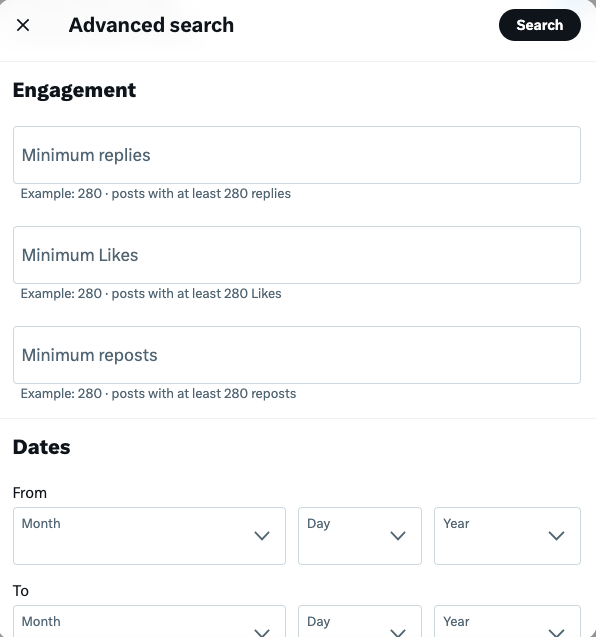
This is a little more challenging to do on other social media platforms that don’t have advanced search features.
Therefore, you’ll probably have to manually scroll through your competitors’ content on those other social platforms to identify their most popular posts.
Alternatively, you can use a tool like Brandwatch or Brand24 to track specific competitors or creators. You can set up these tools to send you automated reports so that you receive weekly, or even daily reports of your competitors’ most successful social posts.
4. Research Trending Topics
Many people use social networks to stay up-to-date with the latest news, so an easy way to generate more engagement on your posts is to simply tap into the latest trending topics.
This post is one of Shaan Puri’s most popular Twitter threads, with nearly 1,000 comments and nearly 4,000 bookmarks. While Shaan is a great copywriter, this post’s popularity is due more to the topic that he selected than any particular copywriting tactic:
While Shaan is simply reporting on breaking news, that isn’t the only option to create content on breaking news.
Here are a few other frameworks you can use to create engaging social posts around breaking news:
- State your predictions
- Provide a controversial take (within reason)
- Provide actionable takeaways from the events
You also don’t necessarily need to use breaking news. You can also tap into long-term trends.
For example, Crumbl Cookies is a fast-growing franchise that has earned plenty of media attention over the past several months/years.
Therefore, this post takes advantage of its growing popularity:

If you need help discovering the latest trends, you can use a tool like Exploding Topics. It allows you to search by topic, and then it shows you the most popular trending topics within that category.
Your social media post is one of tens or even hundreds of posts that a person will likely see in a single session, so if you want them to pause and engage with your content, you need an outstanding hook.
There isn’t a single way to hook your audience, but if you’re feeling stuck, you can use one of these hook formulas.
Formula #1: A (use case of trending topic) that nobody else is talking about
Brendan Hufford has an excellent example of this hook formula. Selecting a popular topic that’s currently trending makes the post immediately interesting, and then he adds intrigue by stating that nobody else is talking about it.
You can see that this was also one of his most popular posts, earning over 73 comments and 19 reposts.
Another bonus tip is to use an emoji at the end of the hook to encourage people to click “read more,” as that engagement action is a positive signal to social media algorithms.
This formula works well because readers will likely pause if you provide a compelling reason why their current strategy is ineffective.
Neil Patel has an excellent example of this formula in action.
The line below the hook mentioning “check out the stats” further strengthens the second half of the hook (why what the reader is doing is ineffective).
This hook works because it sets up a story. Stories are naturally interesting, and this framework naturally opens up a curiosity loop.
Noah Kagan has a popular post that uses this hook.
I swiped this formula from Katelyn Bourgoin, and it’s another great social media copywriting hook because you immediately want to know why someone wouldn’t want that desirable thing.
This is also why it’s important that you understand who your target audience is and their unique pain points.
Formula #5: This (person) went from (pre-transformation metric) to (desirable post transformation metric) in (timeframe). Here’s how
Paddy Galloway has a great example of this case study style hook. He also adds a visual to catch your attention and make it immediately obvious what the transformation looked like.
It’s also important to realize that the effectiveness of the hook depends largely on the level of intrigue and relevancy of the content itself.
For example, if Paddy Galloway’s case study had only increased the channel growth to 2,000 subscribers, it wouldn’t be as compelling.
Similarly, if Katelyn Bourgoin used something less desirable than money, her hook wouldn’t have been as powerful. Therefore, test not only the hook format, but also the idea and topics you use within the hook.
6. Create Mini Payoffs With Curiosity Loops
Think about the last book that you couldn’t put down. The reason you couldn’t put it down is that you had to figure out what was going to happen next.
However, if you don’t anticipate anything happening later in the book, you probably won’t continue reading.
So the secret to creating anticipation is using a curiosity loop.
Curiosity loops raise a question in the audience’s mind, and then you can build tension by agitating the problem and emphasizing why it’s a problem. This keeps them reading until you give them that resolution.
George Blackman articulates this concept very well:
This example from Neil Patel is an excellent example of how to create mini-payoffs:
The key to a great mini payoff is immediately setting up the next question as soon as you resolve the first one. In this example, Neil immediately opens up the next curiosity gap (raises a new question in the reader’s mind) as soon as he gives the first mini payoff.
This curiosity gap ensures the reader will continue anticipating value.
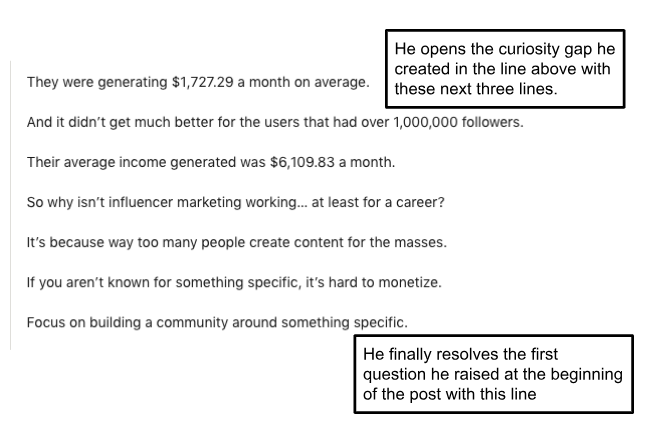
Shaan Puri also has a Twitter thread that’s an excellent example of mini payoffs, blended with great storytelling and humor:
7. Use Contrarian Statements
Using contrarian statements is a great way to generate a lot of engagement with a short social media post.
The post below is one of Anthony Pompliano’s top-performing Tweets, and it’s just four words. However, the statement sparked plenty of debates in the comments that helped the post take off.
Nick Huber is another great example of a Twitter entrepreneur who has a controversial brand voice, and this is one of his most popular Tweets of all time. He took a contrarian stance on HOA, and it sparked more than 5,000 comments.
I also noticed that one of Jesse Pujji’s most popular Tweets is around a rather controversial topic (Elon Musk’s acquisition of Twitter):
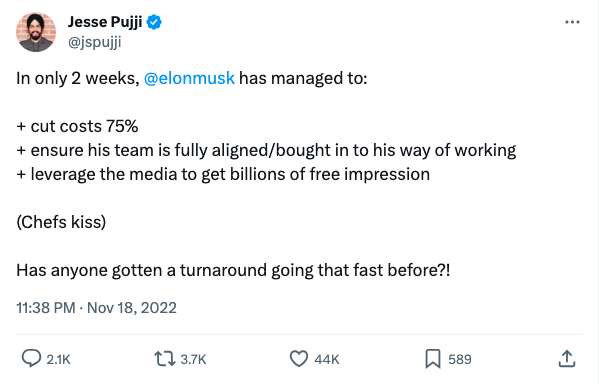
However, if you take a contrarian statement, remember that the goal is to build a loyal following, so be sure the statement is something you truly believe. If it is, it can be a great way to attract the right audience who sincerely believes what you believe.
However, if you’re just doing it to earn more engagement, contrarian statements can actually work against you and hurt your brand’s reputation
If you’re just starting your social media marketing journey, post as much content as possible and try different formats and topic ideas. After you’ve posted content consistently for several months, look at your analytics to determine which formats and topics performed best.
Then, repeat those formats and frameworks.
Here’s a great example from Seso. He tried this format where designers drop an example in the comments, and he tells them something they’re good at.

It worked well, so he reused the same format about two months later, and this post format also went on to be a top performer:
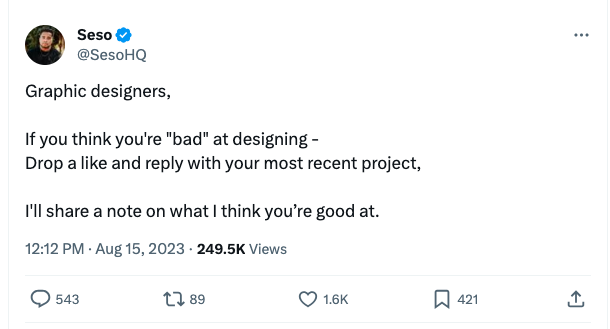
Codie Sanchez also used this strategy. She found that offering a lead magnet in exchange for a comment was a great way to earn more engagement.
It worked well the first time she did it in March of 2022, so she repeated the same format in June.
People don’t want to read long paragraphs, and when they’re scrolling through social media, they want a quick dopamine hit. In addition, your content is right next to other interesting content from their friends and influencers, so you need to make it easy for them to quickly understand what you’re saying.
Therefore, use short sentences, clear and concise language, and visually appealing elements, like emojis.
Many social media platforms also have character limits, so optimize your content to fit within those constraints.
You can also use hashtags to help your post earn more visibility. If you’re not sure what hashtags to use, consider using a hashtag trending tool or look at the hashtags your competitors recently used in their top performing posts.
Images and videos can also help capture your reader’s attention. For example, this post from Paddy Galloway uses an image that essentially asks the question that the thread answers. If you’re not sure what image to use, think about how you would illustrate your hook.
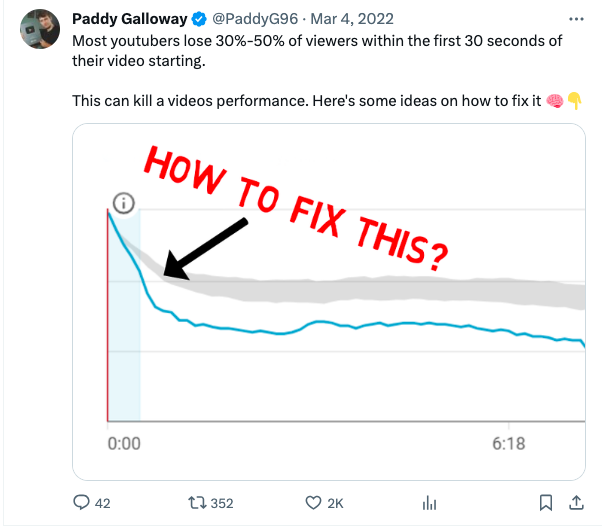
Here’s another great example of an image that creates intrigue and causes the reader to pause and read the hook:
If you’re unsure what image to use, consider taking a real picture rather than a graphic. This style of photo is more personal, which can catch the scroller’s attention and get them to read your post.
This example from Katelyn Bourgoin is perfect:
Images also take up more real estate on the reader’s screen, so adding more pictures forces the reader to spend more time looking at your post.
10. Post Consistently
The best way to get better at writing copy is to practice, test, and improve one thing with each post. Each audience is slightly different, so you need to figure out what they want, and you’ll also have to spend some time finding your own voice.
Therefore, set a goal to post consistently for a set timeframe.
For example, commit to posting daily for 30 days or one post five days per week for six months.
Social media is also unlike SEO and other forms of evergreen content, as social media posts usually only have a lifespan of a matter of hours.
Therefore, posting consistently is not only important for improving your copywriting skills, but it’s also important if you want to succeed on any social media platform.
To help you achieve your goal, set aside an hour or two at the beginning of each week and then you can schedule your content ahead of time in a tool like Buffer to ensure it posts daily.
You can also ask some of your friends to help you stay accountable by doing weekly accountability calls.


























